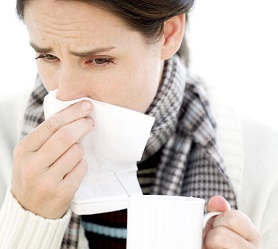 Bronchitis is an inflammatory lesion of bronchial mucosa, as a result of which the drainage function of the bronchial tree is impaired.
Bronchitis is an inflammatory lesion of bronchial mucosa, as a result of which the drainage function of the bronchial tree is impaired.
With illiterate treatment, it goes into a chronic stage and can be complicated by pneumonia, therefore it is important know the causes of its occurrence, the first symptoms and the basics of treating bronchitis at home in adults.
Damage and inflammation of the bronchial tree can arise as an independent, isolated process (primary bronchitis) or develop as a complication against the background of existing chronic diseases and the transferred infections (secondary bronchitis).
Damage to the mucosal epithelium of the bronchi disrupts the secretion, motor activity of the cilia and the process of cleaning the bronchi. Separate acute and chronic bronchitis, differing in etiology, pathogenesis and treatment.
Causes
The most common causes of bronchitis are etoviruses, various bacteria and intracellular parasites. In some cases, the cause may be exposure to toxic gases or allergens. Therefore, the high incidence of bronchitis is due, first of all, to the variety of factors that may trigger its appearance.
Among them the most popular are:
- Viral, bacterial and fungal diseases of the respiratory system (influenza, parainfluenza, laryngitis, pharyngitis).
- Damage to bronchi by toxins, for example, when smoking or working with chemicals.
- Dusty bronchial contamination (most often found in miners).
- The effect of allergens contained in the inspired air (eg, wool, pollen and others).
The main mechanism of development of bronchitis caused by infectious agents is spreading with the air or sputum of the pathogen deep into the respiratory system. Infectious diseases most often cause an acute form of bronchitis.
Acute and chronic
Acute bronchitis- an inflammatory process of the bronchial mucosa, arising from a variety of causes. These include infectious agents, viruses, chemical, physical or allergic factors. With bronchitis, tissues along the walls of the airway are swollen and produce a large amount of mucus.
Chronic bronchitis is a progressive inflammation of the bronchi, manifested by coughing. The chronic nature of the process is usually said if the cough lasts at least 3 months. per year for 2 consecutive years. Chronic bronchitis is the most common form of chronic nonspecific lung diseases, which tends to become more frequent.
Symptoms
The most important sign of bronchitis in adults has always been and remains a cough. In addition, there is another symptomatology:
- temperature increase: significant or insignificant;
- spasms of the throat, painful sensations;
- wheezing, shortness of breath.
If these signs are found, you need to decide how to treat bronchitis so that it does not bring complications.
Symptoms of bronchitis
In case of bronchitis, cough is the main symptom. It is important to understand that in fact a cough is a protective function of the body. In fact, it is an exhaled breath, through which the body tries to get rid of pathogenic agents that get into the respiratory tract (in this case - viruses, bacteria).
In addition, an adult feels a general malaise, a worsening of appetite, quick fatigue, fever. All these manifestations of general intoxication of the body caused by inflammation of the bronchi. The temperature usually reaches high values - 38 -39 ° C. But sometimes it can be lower, it depends on the individual reactivity of the organism.
As a rule, initially cough is dry, but after a few days it becomes productive (moist), at which the sputum is separated. Expectorant mucus when coughing can be transparent or have a yellowish-gray or greenish tinge.
If there is a significant damage to the airways, small vessels of the lung can be damaged, so that there may be impurities in the sputum. The period of acute symptoms in bronchitis, as a rule, lasts 3-4 days. There are also severe pains in the chest. Especially it is characteristic during the cough period. Often patients complain of excessive sweating. When the first symptoms appeared, it is important to think about how to treat bronchitis, and what drugs to use for it.
Symptoms of chronic bronchitis
 In chronic bronchitis, coughing with sparse sputum, dyspnoea with exercise may be a constant symptom that accompanies the patient throughout life.
In chronic bronchitis, coughing with sparse sputum, dyspnoea with exercise may be a constant symptom that accompanies the patient throughout life.
In this case, the exacerbation of bronchitis is said, if there is a significant increase in the above symptoms: increased cough, increased volume of sputum, increased dyspnoea, temperature, etc.
Bronchitis in adults, especially acute, rarely occurs in isolation. Most often it is combined with the phenomena of rhinitis (cold), tracheitis. This certainly affects the overall clinical picture.
Symptoms of obstructive bronchitis
Characterized by a prolonged exhalation, accompanied by a whistle, dry rales and the need to use auxiliary muscles during breathing. Periodically, an intense cough gives way to a weak cough. Body temperature values may fluctuate.
Obstructive bronchitis in adults is especially tedious physically, since in the act of breathing an auxiliary musculature, there is a constant tension in the muscles of the chest, back, neck, etc.
Treatment of bronchitis in adults
First of all, it is a bed rest and a plentiful drink. Acute bronchitis is well treated with sufficient humidity (60%) and temperature (18-20 ° C) in the room where it is located patient, regular intake of warm drink (up to 4 liters per day), prevention of changes in temperature of the inhaled air.
How and what to treat bronchitis in adults - the question is very serious, because the effectiveness of treatment depends on the outcome and prevention of complications.
- Originallyyou need to give up smoking, get rid of bad habits, stop being in conditions with harmful environmental factors. All this will increase the maximum effectiveness of treatment.
- In the second stagemedications are prescribed that expand the bronchi, stimulating the receptors: Salbutamol, Bromide, Ipratropium Bromide, Terbutalin, Fenoterol or others. This stage is primarily designed to solve problems with breathing and acute conditions. If necessary, use antipyretic drugs (ibuprofen, paracetamol).
- The third stageis the appointment of mucolytics and expectorants that help make phlegm less dense and viscous. These drugs contribute to the rapid escape of it from the respiratory tract. Vegetable preparations can be used - Thermopsis, Doctor Mom, althea root, licorice, etc., or synthetic - Lazolvan, Ambrobe, Bromhexine, Acetylcysteine, etc.
- In the fourth stageonly antibiotics remain. In them, there is a need in the case of bacterial bronchial infection, or the development of complications.
Treatment of acute bronchitis should be started immediately, as soon as the diagnosis is established. The earlier the medical measures are taken, the less chance of its complications development. To cure bronchitis should consult a specialist. The choice of appropriate drugs depends on the severity of the process and the prescription of this disease.
How to treat bronchitis at home
 Inhalation with bronchitis in the home is a good and effective way to treat the disease and alleviate its symptoms, especially when there is no possibility of constantly visiting the physio-cabinet.
Inhalation with bronchitis in the home is a good and effective way to treat the disease and alleviate its symptoms, especially when there is no possibility of constantly visiting the physio-cabinet.
- Steam inhalationIs a very affordable method of treatment at home. To carry it out, it is necessary to take a container, put suitable herbs on the bottom, for example, raspberries, linden and mother-and-stepmother, pour it all over with water and bring to a boil. Breathing is necessary through a funnel made of thick paper.
- Inhalation with propolis- bring the water in a saucepan to a boil, add 3-5 ml of alcohol tincture with propolis and breathe over steam for 5-15 minutes. You can make inhalation with a pure propolis - for this you need to heat the water in large capacity, lower it there metal dishes with carefully ground propolis - a small piece, gram 50 and breathe over the steam.
- With strong pain in the chest and dry cough is very useful to doinhalation based on sea salt,1 tablespoon of which should be dissolved in 1 liter of water. If there is no salt, then you can replace it with an artificial analog, which is prepared from 1 teaspoon of table salt, the same amount of soda and 4-5 drops of iodine per 1 liter of water.
- Collection of herbs for inhalation. 50 grams of chamomile herbs, sage medicinal, eucalyptus leaf, licorice, calendula. turn pour a liter of boiling water, insist in a thermos for 2 hours, drain.
For inhalation, special devices (inhalers) and devices (nebulizers) with a special nozzle are often used, through which, in fact, inhalation of therapeutic vapors and aerosols occurs. But in the absence of such special means, at home, you can use and improvised items of kitchen utensils - a kettle, a pot or any other capacity and a towel.
Antibiotics
The question of the advisability of prescribing antibiotics for bronchitis is still very controversial. Many indicate that these drugs destroy the intestinal microflora, inhibit immunity. But in the absence of antibacterial therapy, the infection from the bronchi will pass to the lung tissue, the pleura with the development of pneumonia and pleurisy. Long-term fever - 3 days or more, accompanied by a cough, shortness of breath, requires the appointment of antibiotics.
For the treatment of bronchitis in adults, antibiotics are the drugs of choice:
- penicillins (Amoxicillin, Flemoxin, Augmentin),
- cefalosporins (Cefixim, Cephazoline, Claforan, Cefuroxime, Cefaclor),
- macrolides (Vilprimen, Clarithromycin, Azithromycin, Erythromycin, Macropen, Rovamycin),
- fluoroquinolones (Levofloxacin, Sparfloxacin, Moxifloxacin), etc.
You can use the drug with antibiotics for topical application - Bioparox. The administration of antibiotics to the body can be done orally, parenterally or by inhalation, for example, a nebulizer.
Please note that antibacterial agents are not prescribed in all cases. Therefore, the selection of a specific drug should be weighed, based on the spectrum of action and recommendations of the doctor.

How to choose probiotics for the intestine: a list of drugs.

Effective and inexpensive cough syrups for children and adults.

Modern non-steroidal anti-inflammatory drugs.

Review of tablets from the increased pressure of the new generation.
 Antiviral drugs are inexpensive and effective.
Antiviral drugs are inexpensive and effective.



